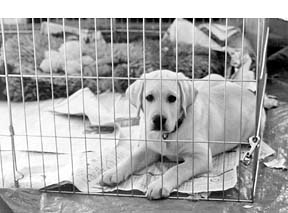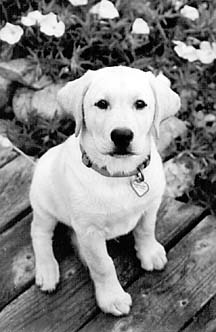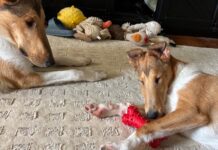The first time I saw Buddy he was a tiny tan morsel nestled in his owner’s arms, a perfect pudge of a yellow Labrador retriever puppy – eight weeks old, fat, round and chunky with a shiny black button nose, warm brown eyes and milk-sweet puppy breath. His owner, Tena, had carried him into my training class to hand him over to me for three weeks of in-home boarding and training.
I generally don’t recommend that an owner send an eight-week-old puppy to a trainer for boarding and training. This is an important learning and bonding period for dog and owner; it is usually more beneficial for the two to learn together. But Buddy’s owners had made some big mistakes in the two weeks they had owned their new puppy.
First, they had purchased him at the age of six weeks, depriving him of a very important two-week period of education and socialization with his mother and littermates. Puppies taken away from their litters at this tender age often have problems with being mouthy (biting too hard on human skin) because they missed out on the chance to learn bite inhibition from their mother and siblings. Unless they are given ample opportunity to socialize with other puppies or gentle adult dogs as they grow up, “only” puppies can become canine social nerds, failing to learn appropriate body language and other canine social skills. And sometimes, puppies taken away from their litters too soon often grow up to be aggressive to other dogs.
The owners’ second big mistake was adopting a six-week-old puppy two weeks before going on a three-week vacation. They had belatedly realized the folly of putting a very young pup in a commercial kennel for three weeks, and had begged me to take him. I agreed, reluctantly. I am not set up to do boarding, and have long resisted adopting a puppy myself because of the huge commitment of time and energy that they require. However, I, too, was reluctant to see Buddy spend these important formative weeks in a kennel, and his owners were willing to pay a considerable sum for the privilege of keeping Buddy at my home. Buddy was coming to stay for three weeks.
My class was just concluding. I dismissed my students and walked outside with Tena to discuss last-minute details.
“Put him down,” I urged her. “Let him walk.”
She gently placed him on the ground and he toddled along behind us as we strolled down the driveway. Suddenly he stopped and sat in the middle of the road. We continued on, and when we had gone about 15 feet she turned back to him.
“What are you doing?” I asked her.
“Going back to get him,” she replied.
Big mistake number three – Buddy’s owner was already getting “trained” to do what the puppy wanted!
“Nope,” I said. “Leave him.”
“Leave him?” There was a note of panic in her voice.
“Leave him,” I insisted. “He’ll come.”
We kept walking, Tena glancing nervously over her shoulder every three steps. Sure enough, we hadn’t gone another 15 feet when Buddy jumped up and came galloping after us. My first lesson for Buddy (and for Tena!) was a success – we were the leaders, and it was his job to keep up with us.
I reassured Tena that Buddy would be fine. She bid him a reluctant good-bye, got in her car and drove away. I used a treat to lure Buddy into the crate I had brought with me, put him in my van and headed home.
Coming Home
“Home” had been prepared for Buddy’s arrival. I had put down a plastic tarp in the living room, covered it with a thick layer of newspaper and set up a puppy pen on top of it. A variety of enticing chew toys awaited Buddy’s needle-sharp baby teeth: a Kong stuffed with cream cheese, a bleached marrow bone filled with peanut butter, a Goodie Gripper with freeze-dried liver jammed into the holes, a Roll-A-Treat Ball full of tasty kibble, a couple of Vermont Chew Toys. We were ready!
We would use the umbilical cord approach to puppy management. Buddy would be kept at all times either in his pen, in the safely fenced and puppy-proofed yard with my dogs, on a leash with me, or under my direct supervision in the house. We would thus avoid a common mistake of novice puppy owners — giving the puppy too much freedom. The first few weeks of puppyhood are a critical time. If the pup’s early behavior is well-managed, he will never learn to chew the furniture, climb on the counters, and urinate in the back bedroom. Through the judicious use of puppy pens, fenced yards, crates, adult dog baby-sitters, leashes and direct supervision, we avoid unwanted behaviors that are much easier to prevent than they are to unteach.
Three Weeks with Buddy
I arrive home with Buddy and introduce him to the Miller pack. I know that none of our four dogs will hurt him, but I also know that they won’t tolerate obnoxious puppy behavior. As he charges through the front gate he is greeted by Josie, our 11-year-old terrier mix and pack leader. Josie promptly lets out a fierce throaty growl that knocks Buddy onto his back. From Tucker, the 75-pound cattle dog mix and Katie, the 45-pound Australian Kelpie, all the way down to Dusty, the eight-pound Pomeranian, each of the four Miller dogs lets Buddy know in turn that they will brook no misbehavior.

I take Buddy inside and put him in the pen, where he promptly begins to cry and shred the newspaper. This is where puppy owners often make another huge mistake. If I heed his cries and relent, letting him out of the pen, he learns an important lesson – crying gets him what he wants. Instead, by ignoring him, I will teach him that crying is not a useful behavior. If I “Click!” a clicker and treat him when he stops crying, he will learn to be quiet even faster. I ignore Buddy’s cries, and within 15 minutes he finally gives up and settles down for a nap.
I start Buddy’s housetraining from day one, teaching him a verbal cue to go to the bathroom, and rewarding him for eliminating. At 11:00 p.m. I wake Buddy and take him outside on his leash. As he squats, I tell him “Go pee!” When he is done, I “Click!” and feed him a treat. After a short wait he also deposits feces, also accompanied by my “Go pee!,” cue followed by a “Click!” and treat. We will do this every two hours throughout each day for the next three weeks, giving him lots of opportunities to do it right, and never giving him the chance to “make a mistake” in the house.
If I made the common novice-owner error of just putting him outside by himself, he could eliminate anywhere he chose. He might not even go to the bathroom at all, especially if I give him a treat when he comes back in. If “coming in” is the behavior that gets rewarded with a treat, he might as well skip the bathroom step!
Having other dogs to play with outside can also distract him from his bathroom purpose – he may be having so much fun playing that he forgets to stop and eliminate. By going out with him, I teach him to relieve himself in the exact spot I want him to use, and I make sure he actually eliminates. (If he doesn’t, I bring him back inside and return him to his crate for a while, then try again.)
By rewarding him immediately after he goes, I make sure he knows what he is getting rewarded for. Using the “Click!” from a clicker gives him a clear message about which behavior is getting rewarded, even if the treat arrives a few seconds later. We will be using the “Click!” a lot with Buddy over the next few weeks. When Buddy is done going to the bathroom, I lead him into the bedroom and toss a treat into his crate.
“Go to bed,” I urge as he pokes his nose into the crate, looking for the treat. A gentle nudge to his tail pushes him into the crate, and he is ready for bed. (Within three days he will voluntarily go into his crate upon hearing the verbal cue, “Go to bed.”) He has had a long, exciting day and is ready to sleep. He cries for a few minutes, but when I continue to ignore him, he curls up and sleeps through the night without a further peep.
The Routine
The following days fall into a routine that centers around Buddy. We wake at 5:30 a.m. to a dry crate, and rush outside for his morning bathroom ritual, then come back inside for breakfast in his puppy pen. The day consists of lots of trips in and out, interspersed with three meals, and several short training sessions. Within two days he is galloping into his pen at the “Go to your pen” cue, ready for his meal. He quickly learns to run up to me and sit for a Click! and treat instead of jumping up. (We accomplish this in less than a day by turning our backs when he jumps up – ignoring the behavior we don’t want – and clicking and rewarding him with a treat when he sits.) By Day 4 he offers a sit for every possible occasion.
He also learns to sit quietly in order to be released from his pen. When I approach the pen gate he must sit in order for me to proceed. If he jumps up, I turn away. When he sits, I start to open the gate. If he gets up, I turn away again. He quickly realizes that the sooner he sits and stays sitting, the sooner the gate opens. If he gets up before I release him, I close the gate again. I don’t even have to ask him to sit – he chooses to sit because that gets him what he wants – out! He is learning to control his own behavior without being nagged by me to do the “right” thing. This is a key element of positive reinforcement training – teaching the dog to take responsibility for his own behavior rather than always being told what to do.
On Day 3, after just one session with the clicker, he learns to lie down on a verbal cue. We start by “luring” him down with a treat without even using the word “down,” and “Click!” and treat him when he does it. Once he does the “down” behavior smoothly, we add the word to tell him what he is doing, as he does it, still clicking and treating for each “down.”
After a dozen or so repetitions, I ask for the “down” first, then lure with the treat, followed by “Click!” and reward. It only takes a couple of dozen repetitions for Buddy to understand that the word “Down” means the same thing as luring “down” with the treat, and he is soon dropping like a rock to the floor on the verbal cue alone.
As expected, Buddy is excessively mouthy. When I offer him a treat, he chomps down on my hand. His sharp little teeth hurt! I consciously resist the impulse to punish him for the pain he inflicts on me – instead I begin to teach him to soften his uninhibited bite. I offer the treat in my closed fist, and suffer the discomfort of his teeth until I feel his bite begin to gentle. As soon as the bite softens, I say “Gentle,” then I “Click!,” tell him “Take it!” and give him the treat. He soon learns that he doesn’t get the treat until he is gentle with his mouth. Although I see progress within a few days, it takes the entire three weeks to get him as soft with his mouth as I want him to be.
A Constant Watchful Eye
Anytime Buddy is given house freedom he requires direct supervision. He wants to eat everything! Distracting him with the Chew Man only lasts as long as I play with him. We work on increasing his self-control. I sit on the sofa and ask him to “Down” at my feet. At first I “Click!” and reward him just for the down. Then I gradually increase the length of time between the cue for “Down” and the “Click!” and reward. (“Gradually” means a few seconds at a time!) By the time Buddy returns to his owners, he will lie quietly at my feet for as long as a half-hour.
We walk on leash to the mailbox every morning to get the newspaper. He is overcoming his tendency to sit and wait to be picked up, and is beginning to walk nicely by my side. I “Click!” and reward him a lot whenever he walks with me, and stop and stand still if he pulls on the leash. He soon learns that pulling does not get rewarded – the more he pulls, the longer it takes him to get where he wants to go.
Encouraging Good Behavior
On Day 4 the newspaper is lying on the ground. Buddy grabs it in his mouth. Having spent the last three days taking forbidden items away from him, I have to stifle my immediate instinct to take it out of his mouth. This is a good behavior to encourage! I allow him to carry the paper proudly back to the house, where I trade him for a treat. From that morning on, he fetches the newspaper every day.
It is possible to completely inhibit a dog’s natural retrieving tendencies by punishing him every time he puts something in his mouth. I encourage Buddy to pick up, play with and fetch appropriate play toys. I use the words I want him to learn – “Fetch” when he runs to get the toy that I throw, and “Give” when he brings it back.
Of course, he doesn’t know what “Give” means until I teach him. He is reluctant to unclamp his tiny jaws from his favorite chew toy, so I offer to trade him for a treat. Bingo! He lets go of the toy as I say “Give,” and I “Click!” and reward him with the treat for his good behavior. We use this same method to get him to give up a forbidden item, and thus avoid teaching him to play keep-away by chasing after him when he has something he shouldn’t. We try to keep inappropriate objects off the floor and out of his reach, but he always seems to be able to find something he is not supposed to have!
By the beginning of the second week I am looking for new challenges for Buddy. He loves to splash in his water bowl, so we buy a baby’s swimming pool and teach him to play in the water. He is hesitant at first, but within a few days he is leaping into the pool to fetch his toys. He accompanies me to my “Dog Days of Summer” lecture at the Santa Cruz SPCA, acting as my “demo” puppy for the “Puppy Stuff” lecture. His quick response to the clicker wins several converts over to the positive reinforcement method of dog training. I also take him with me to do a television show promotion for the lecture series, and on T.V. we demonstrate clicker training and puppy behavior management tools such as the Kong stuffed with cream cheese.
We spend the third week polishing his behaviors and preparing to return him to Tena. He has added “Come,” “Stay,” “Off,” “Relax,” and “Touch,” to his repertoire. He sits and downs promptly on cue, and walks nicely on a leash. He goes into his pen and stays there without protest, sleeps through the night in his crate without a sound, and is allowed much more house freedom, although still with supervision. He can last six hours in his pen without soiling his papers, and in three weeks has only had one accident in the house. I am exhausted. It takes so much work to properly raise a puppy! It is no small wonder that so many dogs end up at animal shelters – there are far too many puppies who never get they attention the need to become well-behaved canine citizens.
In preparation for returning Buddy to Tena, I review all that he has learned in three weeks. I recognize that there is an inherent satisfaction in shaping a puppy’s behavior, watching him explore the world and teaching him to be a good canine citizen. And while I look forward to the relief of returning Buddy to his owners and having my own household return to normal, I worry whether his people will keep up with his training and behavior management. I realize that I will miss this bright little guy with his boundless enthusiasm for life and learning.
Epilogue
Buddy’s owners were quite pleased with the results of his stay at “Camp Miller,” and signed him up for one of my Peaceable Paws puppy training classes. Buddy and I were delighted to see each other when he arrived for class, where he was handled by his owner’s son, seven-year-old Mark. Buddy and Mark graduated from the class with honors.
Pat Miller is a regular contributor to WDJ. A freelance writer and dog trainer, she lives in Salinas, California.





